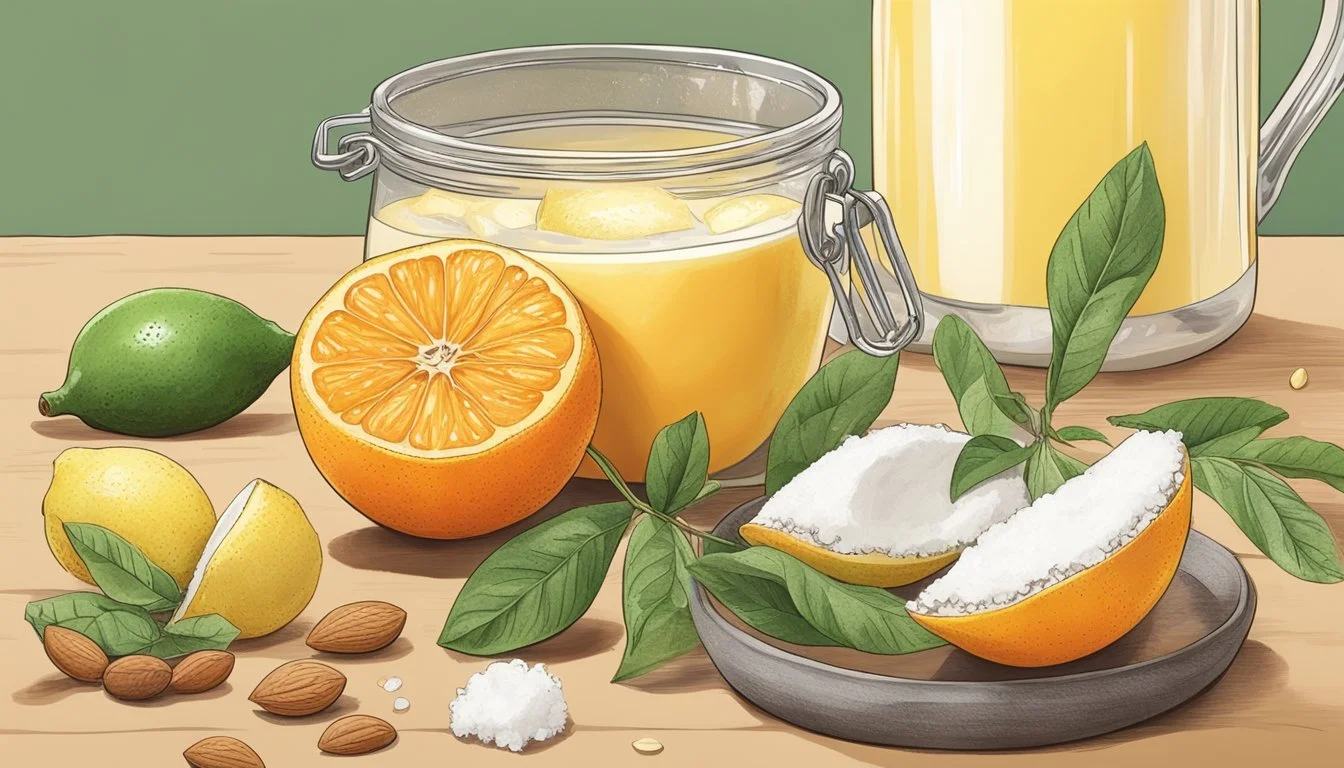Tangerines Substitutes
Best Alternatives for Cooking and Baking
When tangerines are not available or suitable for a particular recipe, several substitutes can provide similar flavors and nutritional benefits. Oranges often serve as the best substitute due to their sweet and tangy flavor profile, closely mirroring that of tangerines. They can be used in both fresh and juiced forms, making them versatile in culinary applications.
Clementines, another popular alternative, offer a slightly sweeter taste and are easy to peel, much like tangerines. They are a great option for those looking to maintain the convenience and nutritional value that tangerines provide. Kumquats, despite having a higher citrus oil content, offer a unique sweet-tart flavor that can elevate certain dishes.
For those seeking an unconventional but effective substitute, mango juice provides vibrant flavors and a luscious texture. Packed with essential vitamins, minerals, and antioxidants, mango juice not only matches the sweetness but also enhances the nutritional value of your recipes. These options ensure that your dishes remain flavorful and nutritious, even when tangerines are not on hand.
Understanding Tangerines and Their Unique Qualities
Tangerines, known for their vibrant sweet flavor and thin, easy-to-peel skin, have distinct qualities that set them apart from other citrus fruits. They are rich in Vitamin C and dietary fiber, making them both delicious and nutritious.
Nutritional Benefits of Tangerines
Tangerines offer a wealth of nutritional benefits, primarily due to their high Vitamin C content. A single tangerine provides a significant portion of the daily recommended intake for this essential vitamin. Vitamin C is crucial for maintaining a healthy immune system and skin health.
In addition to Vitamin C, tangerines are a good source of dietary fiber. Fiber aids in digestion and helps maintain a healthy gut. Tangerines also provide various minerals, including potassium and folate, contributing to overall wellness.
Culinary Uses of Tangerines
Tangerines are incredibly versatile in the kitchen. Their sweet flavor makes them a perfect addition to desserts, such as tarts and cakes. The zest of tangerines, which is rich in aromatic oils, is often used to add a citrusy note to cocktails and savory dishes.
Tangerine juice is a refreshing beverage and a flavorful ingredient in marinades and dressings. The thin skin of tangerines can also be candied for a sweet snack or garnish.
Tangerines vs. Other Citrus Fruits
While tangerines share similarities with other citrus fruits like oranges and clementines, they have unique qualities. Unlike oranges, tangerines have a thinner skin, making them easier to peel. They are also smaller and often sweeter.
Compared to clementines, tangerines are slightly larger and may have more seeds. Clementines tend to be seedless and slightly milder in flavor. This size and seed difference is due to genetic variations and different cultivars within the citrus family.
Selecting the Best Substitutes for Tangerines
Choosing the right substitute for tangerines depends on the specific flavor profile desired and the availability of alternatives. Many citrus fruits and juices can effectively replace tangerines in various recipes.
Criteria for Choosing Tangerine Substitutes
When selecting a substitute for tangerines, consider the flavor profile first. Tangerines have a sweet and slightly tangy taste, so the substitute should mimic this balance.
Availability is another key factor. Some substitutes may be more readily available depending on the season or location.
Nutrition also matters; some substitutes might offer additional vitamins or health benefits.
Finally, the use case is crucial—what works for a beverage might not be ideal for a salad. For instance, some substitutes may offer a similar flavor but differ in texture.
Top Substitutes for Tangerine
1. Oranges:
Oranges share a very similar flavor profile with tangerines, making them the most straightforward substitute. They are also widely available year-round, which adds to their convenience.
2. Clementines:
Clementines are another excellent alternative, especially since they are easier to peel and often come seedless. Their flavor is nearly identical to tangerines, making them a versatile substitute for both juicing and eating whole.
3. Mango Juice:
For a tropical twist, consider using mango juice. It offers a sweet and tangy flavor that can elevate many recipes. While not a citrus fruit, its vibrant taste makes it a unique substitute.
4. Kumquats:
Kumquats provide an interesting alternative due to their small size and edible skin. They have a higher citrus oil content, offering a stronger burst of flavor, though they might not be suitable for everyone.
5. Grapefruit Juice:
If seeking a bolder flavor, grapefruit juice can be a great option. It brings a tangy edge that can complement cocktails and certain recipes, though it is more tart compared to the sweetness of tangerines.
Substitute Options Based on Use Cases
Tangerine substitutes vary greatly depending on the specific use case, ranging from cooking and baking to making desserts, salads, beverages, and cocktails. These substitutes aim to replicate the citrus flavor and sweet taste of tangerines.
Cooking and Baking with Tangerine Substitutes
When it comes to cooking and baking, oranges and orange juice are the closest match to tangerines. They can be used in a 1:1 ratio in recipes requiring the sweet-tart taste of tangerines. For a more distinct citrus profile, lemons or limes can add a sharper tang, especially in savory dishes or marinades.
Kumquats offer an interesting alternative with their easy-to-peel skin and sweet flavor, though they may have a slightly higher citrus oil content. This can add a bit of zest to dishes but should be used with caution to avoid overpowering other ingredients.
Tangerine Substitutes in Desserts and Salads
For desserts and salads, where a mild and sweet citrus flavor is desired, mandarins or clementines are excellent choices. They are less acidic and sweeter than other citrus fruits, making them perfect for fruit salads, citrus marmalades, or as a topping for cakes and tarts.
Grapefruits can also be used, though they lend a slightly more bitter note. When balanced with other sweet ingredients, they can add depth to salads or desserts. Pomelos offer another alternative, providing a sweet and less tangy option.
Beverages and Cocktails Using Citrus Substitutes
In beverages and cocktails, tangerines can be substituted with mango juice for a refreshing twist. Mango juice brings a sweet and tangy flavor, ideal for cocktails needing a tropical touch.
For a more traditional approach, grapefruit juice or clementine juice can replace tangerine juice, both offering a sweet taste with less acidity. These substitutes work well in classic cocktails and fruit juice blends, adding a citrusy burst without deviating too much from the original flavor profile of tangerines.
Health and Nutritional Considerations
When substituting tangerines in your diet, it is essential to consider the health and nutritional impact. Key nutritional factors include vitamin and mineral content, as well as dietary fiber and sugar levels.
Comparing Vitamin and Mineral Content
Tangerines are rich in vitamin C, providing about 26% of the Daily Value (DV) per small fruit. This vitamin is crucial for immune function and skin health. Substitute options like mango juice can also offer significant amounts of vitamin C, making them viable alternatives.
Potassium is another important nutrient in tangerines, promoting heart health by helping to maintain healthy blood pressure levels. While mangoes provide ample potassium, other substitutes like orange juice and pineapple juice can also supply good amounts of this mineral.
Vitamin A, found in smaller amounts in tangerines, supports vision and immune health. When looking for substitutes, mango juice stands out as it offers more vitamin A compared to tangerines. Note that other substitutes like lemon juice provide less vitamin A.
Dietary Fiber and Sugar Content in Substitutes
Tangerines are a good source of dietary fiber, which aids in digestion and helps regulate blood sugar levels. When considering substitutes, whole fruits like mangoes also provide fiber, whereas fruit juices may lack this benefit due to processing.
In terms of sugar content, tangerines and their substitutes like mango juice and orange juice contain natural sugars. It's important to monitor the sugar levels, especially for those managing blood sugar levels or watching caloric intake. For instance, mango juice can be higher in sugar compared to tangerine juice, impacting calorie intake and blood sugar levels.
Evaluating both fiber and sugar content in substitutes can help maintain a balanced and nutritious diet while making the switch from tangerines.
Exploring Culinary Substitutes
For anyone needing to replace tangerines in their recipes, various citrus and non-citrus alternatives can provide similar flavors and textures.
Citrus Varieties as Substitutes
Oranges: Particularly Navel oranges, offer a sweetness similar to tangerines. They can be used in both sweet and savory dishes. Clementines and Mandarins (including Cuties and Halos) are also excellent as their sweetness and easy-to-peel nature make them convenient swaps.
Grapefruit and Pomelo add a slightly more bitter and complex flavor profile. These can be useful in salads or as fresh toppings where a tangy note is beneficial. Lemons and Limes are more acidic but can work well in marinades and dressings to add a bright, tangy flavor.
Satsumas, known for their intense sweetness and juicy texture, can be another great substitute. Kumquats, with their tart skin and sweet flesh, provide a unique twist, ideal for garnishes or chutneys. Tangelos combine tangerine sweetness with a hint of tartness, suitable for many culinary uses.
Non-Citrus Alternatives
Mango Juice: With its vibrant, sweet, and slightly tangy flavor, mango juice makes an excellent non-citrus alternative for tangerine juice in smoothies and desserts.
Pineapple Juice: Offers a sweet and tropical flavor, which can be substituted in cocktails and salad dressings.
Apple Juice or Slices: Provide a mild sweetness and neutral flavor, making them a versatile option in both baked goods and sauces.
Passion Fruit Juice: Its tart and sweet notes make it a suitable replacement for adding a tropical flair to recipes.
These alternatives help ensure that the desired flavor profiles and textures remain pleasing and balanced in various culinary creations.
Practical Tips for Storage and Preparation
Storing and preparing substitutes effectively ensures their freshness and flavor. Handling peel and zest appropriately can add an extra punch to dishes, offering both convenience and culinary value.
Storing Substitutes for Optimal Freshness
To keep substitutes such as orange juice, grapefruit juice, or lemon juice fresh, refrigeration is key. Store them in an airtight container at a temperature between 37°F and 41°F (3°C to 5°C).
Frozen substitutes remain fresh for up to 3 to 4 months. Label the containers with the juicing or freezing date to track their shelf life.
For whole citrus fruits, place them in a dark place, like a pantry or fridge, to avoid direct sunlight which can degrade their quality. Consider using a perforated bag to allow air circulation.
Preparing Substitutes to Retain Flavor
Preparation starts with choosing ripe but not overripe fruits. Firmness and bright color are indicators of good quality.
Juicing: Use a manual or electric juicer to ensure a high yield without losing essential oils.
Slicing: Ensure sharp knives are used to avoid bruising the fruits which can affect the flavor.
Sagging or moldy fruits should be discarded immediately to prevent cross-contamination with fresh ones.
Zest and Peel: Handling and Usage
The zest from citrus fruits like oranges, lemons, and tangerines can enhance dishes with a fragrant aroma. Use a microplane or zester tool to remove only the colorful outer layer, avoiding the bitter white pith beneath.
Store zest in an airtight container in the fridge for 1 to 2 weeks or freeze it for up to 6 months.
Peels can be used fresh or dried and ground into powder to add a burst of flavor to recipes. For drying, spread peels on a tray and place in a warm area or use a dehydrator.
By focusing on storage and preparation, substitutes maintain their integrity, zest, and flavor for various culinary uses.
Creative Recipes Incorporating Substitutes
Leveraging substitutes for tangerines, various recipes can gain unique flavors while maintaining the tangy and sweet profile of this citrus fruit. From salads to beverages and desserts, different alternatives can enhance multiple culinary creations.
Innovative Salad Recipes with Citrus Substitutes
Replacing tangerines in salads with alternatives like grapefruit and mango can add unexpected bursts of flavor. Grapefruit's tang complements mixed greens and seafood, while mango's sweetness contrasts with spicy elements.
Example Salad: Grapefruit and Avocado Salad
Torn mixed greens
Segments of grapefruit
Sliced avocado
Drizzle of olive oil
Sprinkle of sea salt and pepper
Mango pairs well with spinach and nuts. Mix cubed mango with baby spinach, chopped walnuts, and a honey-lime dressing to achieve a refreshing and nutritious salad option.
Refreshing Beverage Mixes
Cocktails and mocktails benefit greatly from tangerine substitutes like kumquat and clementine. Kumquat adds both tartness and a slight bitterness.
Mojito Variation Featuring Kumquat:
Muddled kumquat slices
Fresh mint leaves
Lime juice
Simple syrup
Soda water
For a balanced, non-alcoholic drink, blend clementine juice with sparkling water and a touch of honey for sweetness. This easy mix provides a refreshing option ideal for any gathering.
Sweet and Savory Desserts
Desserts can shine with creative use of citrus substitutes. Mango offers a creamy texture for sorbets and mousses. Kumquat, finely chopped, works in tarts and cakes.
Mango Sorbet:
Pureed mango
Simple syrup
Lemon juice
Freeze until firm
Kumquat Tart Recipe:
Tart shell
Sliced kumquats
Orange marmalade glaze
Honey enhances both sweet and savory dishes, working well with citrus flavors. Combine honey with** grapefruit segments** for a tangy-sweet topping on cheesecakes or panna cotta.
Incorporating these substitutes allows flexibility in recipes while preserving or enhancing the intended flavor profiles.
Nutrient Preservation in Substitute Fruits
When selecting substitutes for tangerines, it's important to consider how well these alternatives can preserve essential nutrients. Key factors include maintaining antioxidant levels and reducing inflammation through nutrient-rich profiles.
Maintaining Antioxidant Levels
Antioxidants are crucial for neutralizing free radicals and preventing cellular damage. Mandarins and Clementines are rich sources, particularly notable for their high Vitamin C content. This vitamin is essential for skin health, immune function, and wound healing.
Kumquats also offer a good source of antioxidants. The thin skin is not just easy to peel but contains significant amounts of nutrients.
Another valuable substitute is Mango Juice, which is packed with vitamins and minerals, providing effective antioxidant protection. Its high levels of Vitamin A and E help promote cellular health and support the immune system.
Substitute Fruit Key Antioxidants Mandarins Vitamin C, Flavonoids Clementines Vitamin C, Flavonoids Kumquats Vitamin C, Vitamin A Mango Juice Vitamin A, Vitamin E
Approaches to Reduce Inflammation
Reducing inflammation is another essential aspect of nutrient preservation. Lemon and Lime Juice contain citric acid and Vitamin C, which can mitigate inflammation processes within the body.
Clementines also help due to their folate content. Folate plays a role in reducing homocysteine levels, which are associated with inflammation risk.
Additionally, Oranges and Their Zest are beneficial. The zest is rich in flavonoids which have been found to possess anti-inflammatory properties, further aiding in inflammation control.
Incorporating these substitutes appropriately can help maintain optimal health benefits, particularly when tangerines are unavailable.










